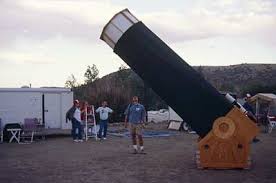Exploring the Universe: The Wonders of Large Telescopes
Large telescopes have revolutionized our understanding of the cosmos by allowing us to peer deeper into space than ever before. These impressive instruments, with their massive mirrors and advanced technology, have opened up new frontiers in astronomy and unlocked mysteries of the universe.
The Power of Large Telescopes
Large telescopes, such as the Hubble Space Telescope and the Keck Observatory, are equipped with mirrors that can capture and focus light from distant celestial objects. By collecting this light, astronomers can study galaxies, stars, planets, and other cosmic phenomena in incredible detail.
Advancements in Astronomy
The development of large telescopes has led to groundbreaking discoveries in astronomy. From identifying exoplanets orbiting distant stars to capturing images of black holes at the center of galaxies, these telescopes have broadened our knowledge of the universe and reshaped our understanding of space and time.
Exploring the Unknown
Large telescopes play a crucial role in expanding our understanding of the cosmos. By observing distant galaxies billions of light-years away or studying the remnants of exploded stars, astronomers can unravel the mysteries of the universe and gain insights into its origins and evolution.
The Future of Astronomy
As technology continues to advance, large telescopes will only become more powerful and sophisticated. Projects like the James Webb Space Telescope promise to push the boundaries of exploration even further, offering unprecedented views of distant galaxies and helping scientists unravel some of the universe’s most enduring secrets.
In Conclusion
Large telescopes represent humanity’s insatiable curiosity about the cosmos and our desire to explore beyond our own planet. These remarkable instruments continue to inspire wonder and awe as they reveal the beauty and complexity of the universe on a scale that is truly breathtaking.
7 Essential Tips for Maximizing Your Large Telescope’s Performance
- Choose a telescope with a large aperture for better light-gathering ability.
- Consider the telescope’s focal length for higher magnification of distant objects.
- Use high-quality eyepieces to enhance your viewing experience with a large telescope.
- Ensure proper collimation (alignment) of the telescope’s optics for optimal performance.
- Take care of the telescope’s lenses and mirrors by cleaning them gently and regularly.
- Avoid observing near sources of heat to prevent image distortion due to air currents.
- Allow time for the telescope to acclimate to outdoor temperatures before stargazing.
Choose a telescope with a large aperture for better light-gathering ability.
When selecting a telescope, opt for one with a larger aperture to enhance its light-gathering capability. A telescope’s aperture size directly influences the amount of light it can collect from celestial objects, resulting in clearer and more detailed observations. By choosing a telescope with a larger aperture, astronomers can improve their ability to study distant galaxies, stars, and other cosmic phenomena with greater precision and clarity.
Consider the telescope’s focal length for higher magnification of distant objects.
When selecting a large telescope, it is essential to consider the telescope’s focal length to achieve higher magnification when observing distant objects in space. A longer focal length allows for increased magnification, enabling astronomers to capture finer details of celestial bodies that are located far away. By choosing a telescope with an appropriate focal length, astronomers can enhance their viewing experience and gain a clearer understanding of the intricate features present in the vast expanse of the universe.
Use high-quality eyepieces to enhance your viewing experience with a large telescope.
To enhance your viewing experience with a large telescope, it is advisable to use high-quality eyepieces. The quality of the eyepiece can significantly impact the clarity and detail of the celestial objects you observe through the telescope. Investing in premium eyepieces can improve image sharpness, contrast, and overall viewing satisfaction, allowing you to fully appreciate the wonders of the universe with greater precision and clarity.
Ensure proper collimation (alignment) of the telescope’s optics for optimal performance.
Ensuring proper collimation, or alignment, of a telescope’s optics is essential for achieving optimal performance. A well-collimated telescope allows light to be focused precisely, resulting in sharper and clearer images of celestial objects. Proper alignment not only enhances the viewing experience but also ensures that the telescope functions at its best capacity, allowing astronomers to capture finer details and explore the wonders of the universe with greater clarity and accuracy.
Take care of the telescope’s lenses and mirrors by cleaning them gently and regularly.
To ensure optimal performance and clarity in observing the wonders of the universe through a large telescope, it is essential to take care of the telescope’s lenses and mirrors by cleaning them gently and regularly. Dust, dirt, and debris can accumulate on the surfaces over time, affecting the quality of observations. By maintaining a routine cleaning regimen with soft, lint-free cloths and appropriate cleaning solutions, astronomers can preserve the integrity of the optics and ensure a clear view of celestial objects for continued exploration and discovery.
Avoid observing near sources of heat to prevent image distortion due to air currents.
To ensure clear and accurate observations with large telescopes, it is crucial to avoid observing near sources of heat. Heat sources can create air currents that cause image distortion, affecting the quality of the data collected. By minimizing exposure to heat sources, astronomers can maintain stable viewing conditions and capture precise images of celestial objects with minimal interference.
Allow time for the telescope to acclimate to outdoor temperatures before stargazing.
It is important to allow sufficient time for the telescope to acclimate to outdoor temperatures before embarking on a stargazing session. Sudden temperature changes can affect the performance of the telescope, particularly its optics, leading to distorted views and compromised observations. By giving the telescope time to adjust to the ambient temperature, astronomers can ensure optimal viewing conditions and enjoy clearer, more detailed images of celestial objects in the night sky.

